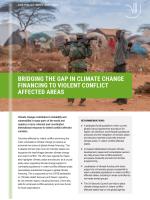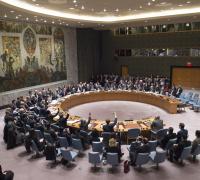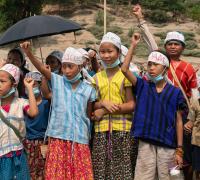Bridging the gap in climate change financing to violent conflict affected areas

- A dedicated funding platform within current global finance agreements that allows for higher risk tolerance, more flexible operational protocols and the integration of climate, peace and security expertise could help enhance climate action in violent conflict-affected states.
- Increased collaboration between climate-development, peace and humanitarian sectors can help ensure that conflict-sensitivity and peace dividends are built into climate programming.
- Localisation of climate funding with direct support to civil society groups is essential to reach vulnerable populations in violent conflict-affected states, including in areas controlled by non-state armed groups.
- The UN Security Council can help to place climate change action in violent conflict-affected states high on the global agenda.
Countries affected by violent conflict are among the most vulnerable to climate change yet receive an extremely low share of global climate financing. This is despite the fact that most UN member states now recognise the interlinkages between climate change and violent conflict. The UN’s New Agenda for Peace also highlights ‘climate, peace and security’ as a crucial policy area. Upgrading climate change support to vulnerable populations in violent conflict-affected areas necessitates substantial changes to global climate financing. This is supported by the COP28 declaration on “Climate, Relief, Recovery and Peace”, signed by 91 UN member states, including Denmark, which also calls for enhanced conflict-sensitivity and more funds for local organisations.
The conflict-climate finance gap
Since 2018, the Climate Security Mechanism – a joint initiative between the United Nations Environment Programme (UNEP) and the United Nations Development Programme (UNDP) – has provided multidisciplinary support to member states, regional organisations and UN entities to better understand the linkages between climate, peace and security. There is now widespread agreement that climate change, although not itself a cause of violent conflict, creates additional risks to peacebuilding and security, especially in contexts with a history of conflict. Reversely, violent conflicts exacerbate vulnerabilities by reducing people’s ability to cope with the effects of climate change and by harming assets that facilitate adaptation. Violent conflicts also cause environmental damage, threatening sustainable land use and ecosystems. Conversely, climate change interventions that are not conflict-sensitive and do not accommodate equity concerns can exacerbate existing conflicts.
Despite widespread agreement on these multiple linkages, global climate financing has largely failed to reach violent conflict-affected states, thus leaving behind populations most vulnerable to climate change and high security risks. There are four core reasons for this.
Firstly, most global climate financing is through non-concessional bilateral loans, the requirements of which most states with violent conflict are unable to meet. Vertical climate finance bodies such as the Green Climate Fund (GCF) and the Global Environmental Facility (GEF) prioritise large, multi-million-dollar projects in safe operating environments which offer the possibility of financial returns on investment and project success. The GCF has recently developed a small-scale project mechanism to support smaller grants, but they maintain rigid accreditation standards, and cumbersome project approval processes, which conflict-affected states and local organisations within them struggle to meet.
Secondly, climate finance tends to be risk adverse. Many bilateral and UN development agencies are reluctant to implement projects in violent conflict-affected areas due to high security risks, additional costs, capacity gaps and the risk that interventions aggravate conflict dynamics. While UN entities increasingly emphasise the need to mainstream climate-security risks into the climate finance architecture, access requirements are complex and rely on stringent fiduciary and safeguarding standards. These barriers also prevent local organisations from accessing climate finance due to their limited administrative capacity.
Thirdly, the largest proportion of climate change finance is channelled through the state, but in violent conflict-affected contexts, state institutions are often unable to reach the most vulnerable populations because the state is only one amongst many actors, including non-state armed groups, that yields control. Although intended to ensure country ownership, the general requirement of central state approval of climate funding, such as the GCF’s no-objection letters (NOL), complicates access to vulnerable populations in areas outside state control. When the state is party to a conflict, state-led climate programming risks legitimising violence and human rights abuses, potentially enhancing conflicts and the underlying causes of vulnerability, such as poverty, inequality and land dispossession.
Fourthly, despite policy-level recognition of the climate, peace and security linkages, UN inter-agency coordination remains a challenge. Climate change programming has traditionally been embedded within the UN development sector rather than been the mandate of UN peace and security bodies. Discussions of complementarity between UN bodies are emerging, and the UN Security Council (UNSC) has been encouraged to place climate-(in)security high on its agenda, but some members worry that framing climate change as a security issue would divert climate financing away from developmental needs.
Despite widespread agreement on these multiple linkages, global climate financing has largely failed to reach violent conflict-affected states, thus leaving behind populations most vulnerable to climate change and high security risks.
Myanmar and Somalia exemplify the different challenges of climate financing to extremely climate vulnerable and violent conflict-affected contexts.
Myanmar
Myanmar’s extreme vulnerability to climate change has worsened since a military coup in 2021, which triggered widespread military atrocities and a nationwide resistance movement. Prior to the coup, almost all international climate change support was channelled through the central state, but most of this has been suspended due to the illegitimacy of the regime, which is not recognised by the UN. Large areas of the country are now controlled by a mixture of non-state armed groups (NSAGs), including ethnic resistance organisations (EROs) and People’s Defence Forces, pro-democracy civilian groups and new state-level bodies that all oppose the military. Some of these actors are developing climate policies and environmental protection initiatives, often through engagement with local and indigenous-led civil society organisations (CSO), which have decades of experience with community-led forest, land and water management. The Karen National Union (KNU), Myanmar’s oldest ERO, has already implemented forest conservation and biodiversity protection areas and is developing a climate action plan, including a carbon reduction emissions scheme. Although other NSAGs have engaged in environmentally destructive activities, they have shown a willingness to respond to pressures from their own people and CSOs to follow the example of the KNU.
While UN and bilateral doners inside the country are supporting some small-scale climate initiatives, data collection and climate sector dialogue, their attempts to channel funds directly to locally-led adaptation and environmental protection initiatives are constrained by the current global climate finance set-up. The fact that many environmental organisations and activists operate in areas controlled by NSAGs that the Myanmar military restricts access to also limits UN and donor outreach and impedes collaboration. Reluctance to work with NSAGs is, however, decreasing as they have already demonstrated the organisational capacity to coordinate with external humanitarian relief efforts with respect for international law.
Somalia
Somalia, one of the world’s most climate vulnerable countries, has a very low capacity to improve resilience due to its weak governance structures and insecure operational environment. Unlike Myanmar, there are ongoing international efforts to implement the climate, peace and security agenda through, for example, a UN climate security advisor, state capacity building, adaptation projects and community-based climate security action plans. The Green Climate Fund (GCF) is preparing to invest more than $100 million to boost climate resilience in Somalia’s agricultural sector. However, due to the capacity constraints of the government, there are still questions about how these funds will be spent. Unlike Myanmar, Somalia also lacks strong CSOs on climate change and environmental protection, and much of the climate finance is channelled through international agencies such as the UN and the World Bank.
A significant challenge is that climate funding does not sufficiently reach areas controlled by NSAGs or by state-like bodies opposed to the Somalia Government, which account for a large part of the country. Somaliland is receiving some climate change support, but its government is virtually excluded from global climate finance due to its lack of international recognition. In the terrorist listed Al Shabab controlled areas, there are no internationally funded climate projects, but the ongoing humanitarian aid could be an entry point for integrating climate resilience with peace and security initiatives through inter-agency collaboration. Al Shabab has shown willingness to assist local communities facing climate shocks and are implementing laws against deforestation and single-use plastics. However, with the significant security risks and political dilemmas associated with Al Shabab, there is a need to find ways to work directly with clan elders to build the capacity of community-led committees in these areas.
A dedicated funding platform
A possible solution to enhance climate action in violent conflict-affected states is to mainstream conflict-sensitivity and establish a ‘dedicated funding platform’ within current global finance agreements, such as the Green Climate Fund (GCF). This aligns with the new funding window within the UN Peacebuilding Fund (PBF) for more risk-tolerant climate finance with peace dividends, but it would also channel funding to violent conflict-affected states not targeted with UN peacebuilding efforts. The platform should enable funding with higher risk tolerance and special access requirements aligned to complex and insecure operating environments. This means lowering some of the burdensome requirements and creating more flexible operational protocols adapted to the changing contours of conflict and state fragility. To address the complexity of implementation in violent conflict-affected contexts and secure alignment with peace building and security concerns, the platform should draw on a mixture of peace, security, armed group, humanitarian, climate and development expertise. This would facilitate cross-learning and knowledge exchange and help break down the operational silos between humanitarian, climate-development and peacebuilding sectors. While the funding platform would be managed at the global level, there should be country-specific and/or regional coordination bodies to promote cross-sectoral programming. For countries with illegitimate regimes and in areas controlled by NSAGs, the platform should have a process for removing the state approval requirement, such as the NOLs. In such situations, donors should instead rely on the localisation of funding to CSOs through collaboration with the humanitarian sector.
In countries like Myanmar with illegitimate regimes or Somalia where the government lacks control of large portions of the country, lessons from the humanitarian sector can support a more pragmatic approach to working with local actors in areas controlled by non-state armed groups.
Localising climate finance
Localisation is gaining momentum in international support to climate change and is often the only option in violent conflict-affected countries. As in stable contexts, localisation challenges dominant state-centric funding, enabling more direct involvement and capacity building of local organisations. In conflict-affected countries, localisation requires specific financing and operational requirements with in-built flexibility and simplified accreditation requirements to support community-led mitigation and adaptation activities for sustainable livelihoods. In countries like Myanmar with illegitimate regimes or Somalia where the government lacks control of large portions of the country, lessons from the humanitarian sector can support a more pragmatic approach to working with local actors in areas controlled by NSAGs. Given the dilemmas associated with NSAGs, funds should not be directly channelled to NSAGs but to CSOs and local committees. This should include civil society capacity building with attention to longer-term climate resilience, institutional sustainability and peace dividends. Funding to CSOs to constructively engage with those NSAGs that demonstrate a willingness to support environmental protection and climate adaptation to the benefit of vulnerable populations should also be considered on a case by case basis.
The role of the UN Security Council
Strengthening the climate, peace and security agenda as part of the UNSC’s mandate represents an opportunity to promote a more coherent strategy for integrating climate change resilience, humanitarian support and peacebuilding operations in ways that acknowledge the co-benefits of climate action for peace and security. The permanent and non-permanent members of the UNSC should use their influence within the UN system to place the needs of violent conflict-affected states high on the global agenda, including support for a dedicated funding platform which helps to channel climate funds to local organisations working in areas controlled by NSAGs.
This publication is part of the “UN Peace and Security Studies” with financial support from the Ministry of Foreign Affairs of Denmark. It reflects the views of the author(s) alone. It draws on desk-based research of academic publications, aid agency reports, media sources, independent research and expert interviews with researchers, analysts and policy makers. The findings on Myanmar are also based on insights from the MyCClimate research project, coordinated by DIIS, and funded by the Danish development research grant, under the Danish Ministry of Foreign Affairs.
DIIS Eksperter





